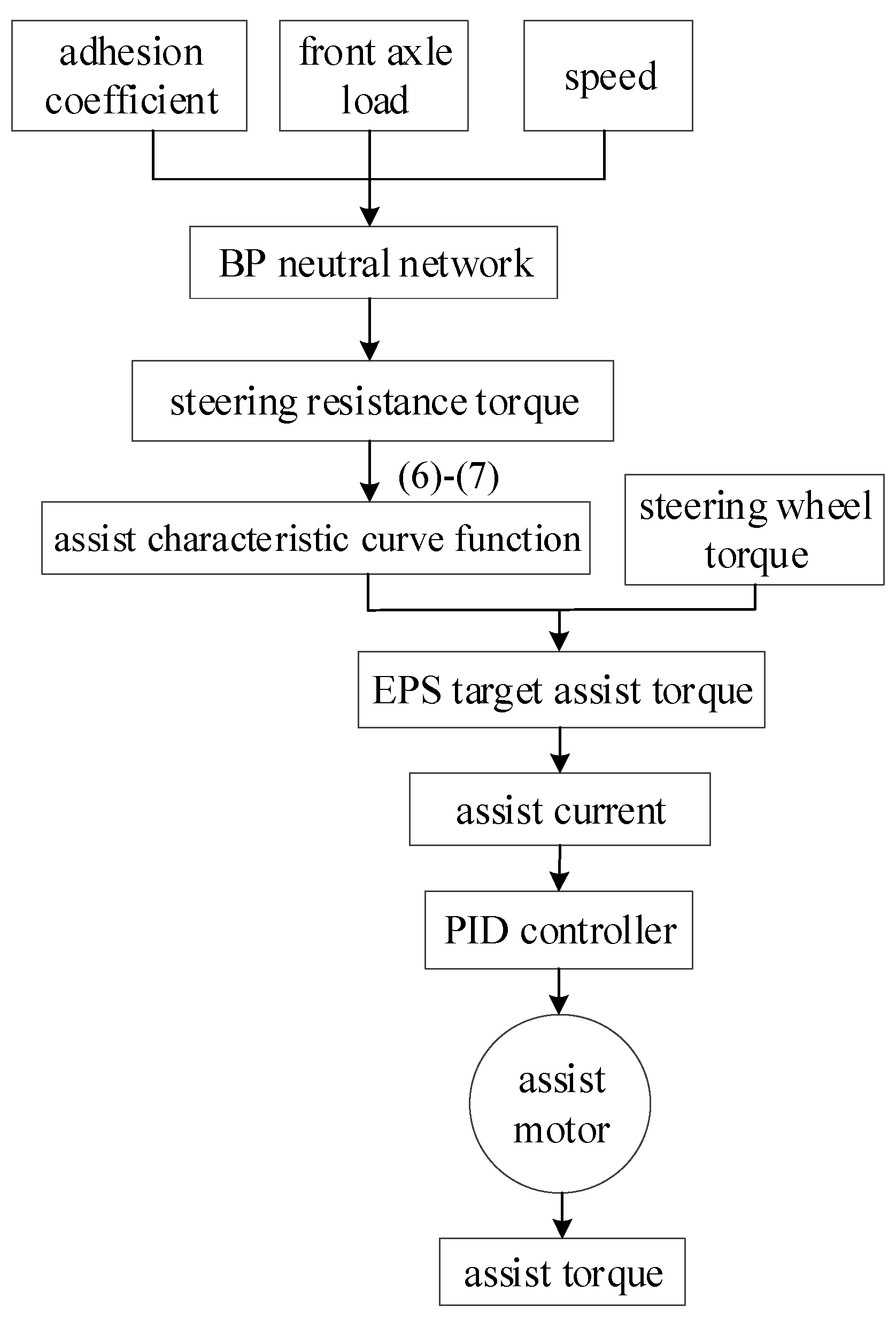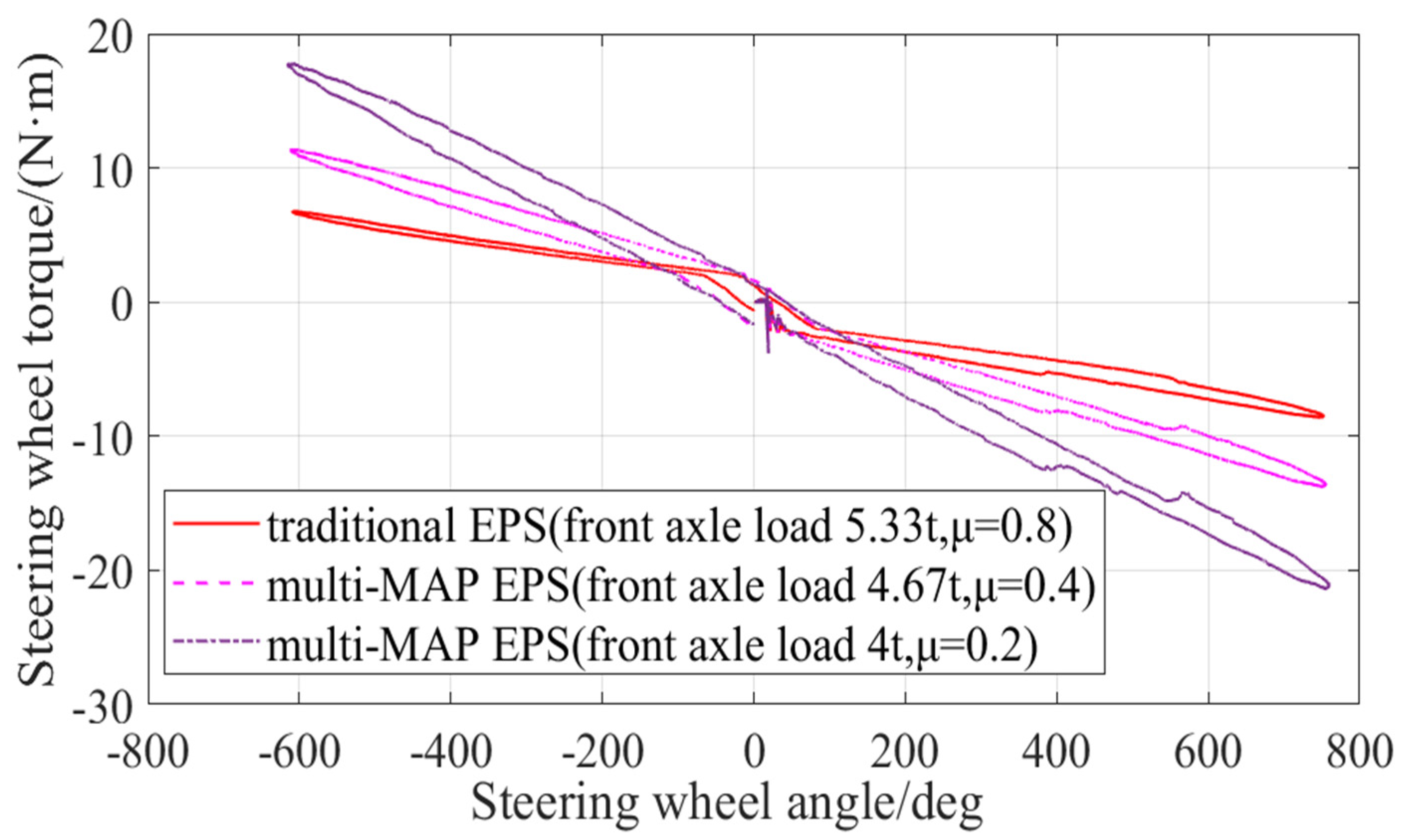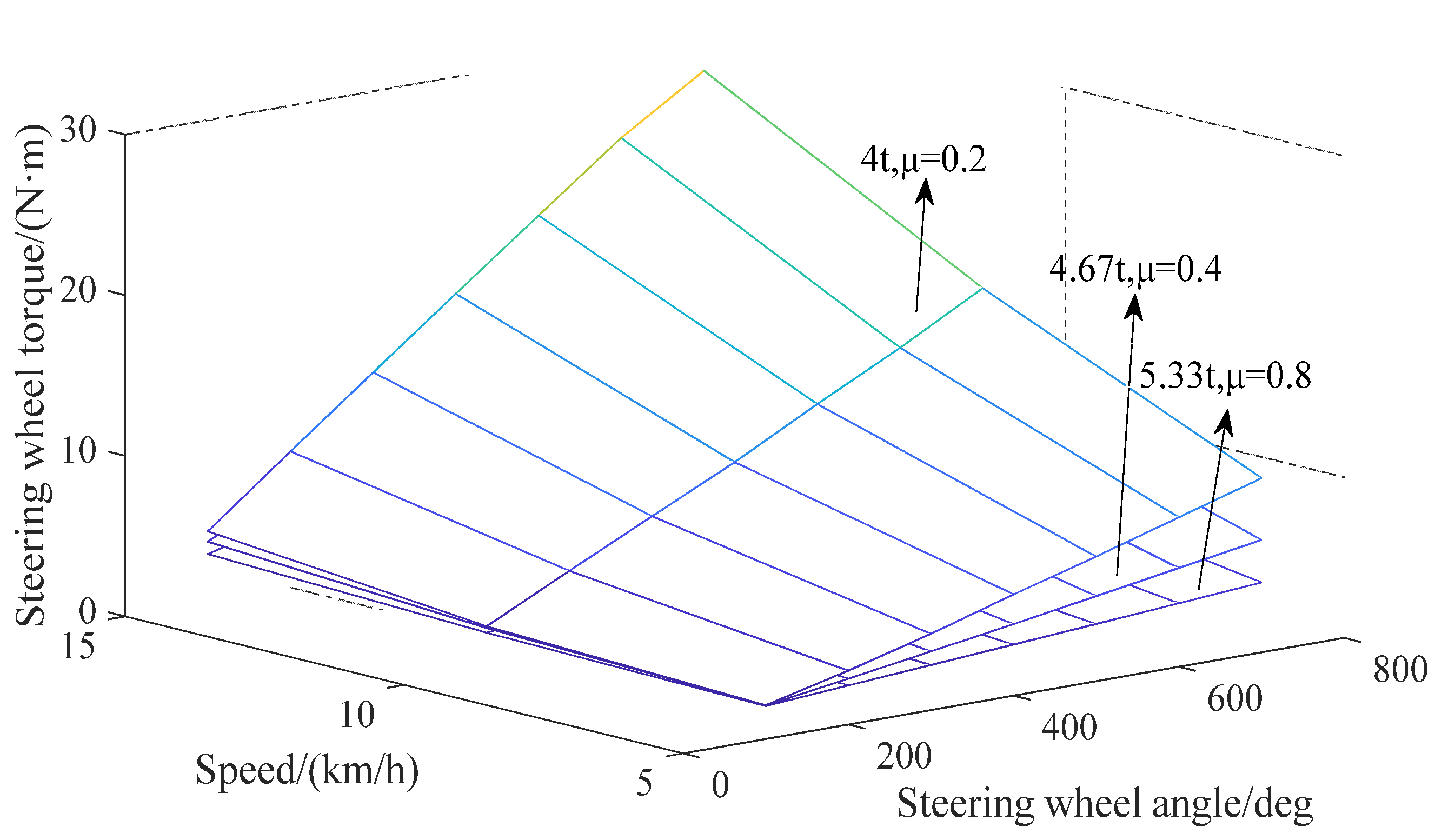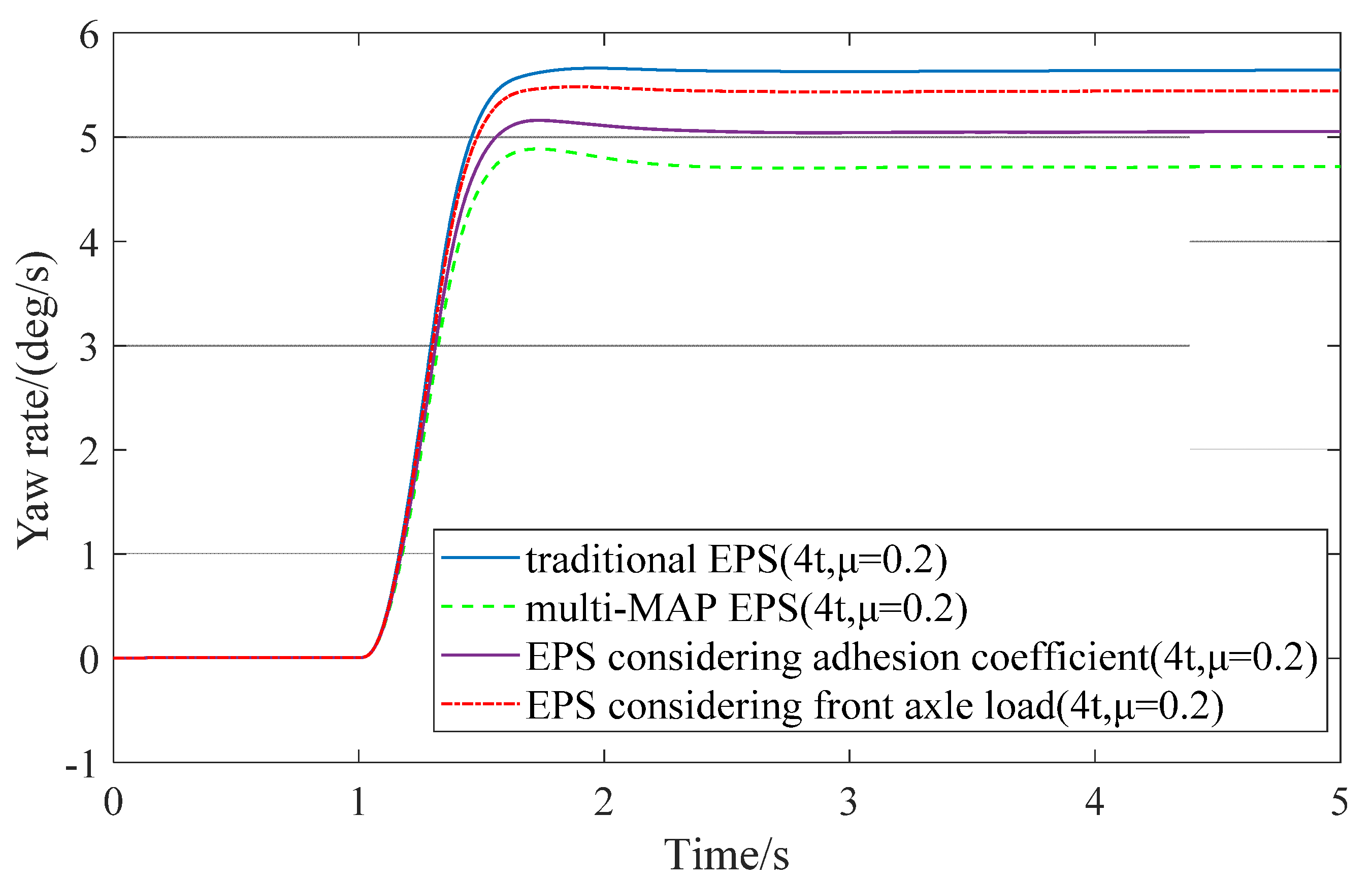Study on Control Strategy of Electric Power Steering for Commercial Vehicle Based on Multi-Map
Abstract
:1. Introduction
- When the front axle load decreases or the road adhesion coefficient becomes smaller, the steering resistance torque will decrease. However, the traditional EPS does not take them into account and gives too much assist torque, which will reduce the driver’s road sense and affect the safety of driving. Thus, the EPS control strategy needs to consider them comprehensively.
- BP (Back Propagation, BP) neural network is used to determine the resistance torque under different front axle load and adhesion coefficient conditions, and an EPS control strategy based on multiple-MAP is proposed.
- Simulation results show that the EPS control strategy based on multiple-MAP meets the requirements of the national standard for steering portability and improves the handling stability of vehicle, increases the driver’s road feeling under a light load and low adhesion coefficient condition, and improves driving safety.
2. Influence of Front Axle Load and Road Adhesion Coefficient
3. EPS Control Strategy Based on Multi-Map
3.1. Determination of Steering Resistance Torque under Different Front Axle Loads and Road Adhesion Coefficients
3.2. EPS Control Strategy Based on Multiple-MAP
4. Simulation Verification
4.1. Steering Portability Test
4.2. Steering Hand Torque Characteristic Verification
- (1)
- The steering hand torque increases with the increase of vehicle speed.
- (2)
- The steering hand torque increases with the increase of steering wheel angle.
- (3)
- The steering hand torque increases with the increase of lateral acceleration.
- (4)
- When front axle load decreases and adhesion coefficient decreases, the driver’s hand torque increases and the steering wheel becomes “heavier”, which improves the ability of the steering system to resist road interference, effectively serving as a reminder to the driver.
4.3. Steering Wheel Angle Step Test
4.4. On-Center Road Feeling Test
5. Conclusions
Author Contributions
Funding
Data Availability Statement
Conflicts of Interest
References
- Rogers, K.; Kimberley, W. Turing steering to electric. Automot. Eng. 2000, 108, 39–41. [Google Scholar]
- Kim, J.H.; Song, J.B. Control logic for an electric power steering system using assist motor. Mechatronics 2002, 12, 447–459. [Google Scholar] [CrossRef]
- Song, J.; Boo, K.; Kim, H.S.; Lee, Y.; Hong, S. Model development and control methodology of a new electric power steering system. Proc. Inst. Mech. Eng. Part D J. Automob. Eng. 2004, 218, 967–975. [Google Scholar] [CrossRef]
- Parmar, M.; Hung, J.Y. A sensorless optimal control system for an automotive electric power assists steering system. IEEE Trans. Ind. Electron. 2004, 51, 290–298. [Google Scholar] [CrossRef]
- Lee, D.; Jang, B.; Yi, K.; Chang, S.; Lee, B. A Novel Electric-Power-Steering (Eps) Control Algorithm Development for the Reference Steering Feel. In Proceedings of the SAE 2016 World Congress and Exhibition, Detroit, MI, USA, 12 April 2016. [Google Scholar]
- Zhao, X.; Shi, X.; Chen, J.; Lee, X. Dynamic correction of the steering-characteristic curve and application to an EPS control system. Int. J. Automot. Technol. 2011, 12, 243–249. [Google Scholar] [CrossRef]
- Li, Y.H.; Fa, Q.L.; Zhang, Y.S. Dual-motor Full-Weight Electric Power Steering System for Commercial Vehicle. Int. J. Automot. Technol. 2019, 20, 477–486. [Google Scholar] [CrossRef]
- Zhao, L.F.; Chen, W.W.; Qin, W.H. EPS control strategy on low adhesion coefficient road. J. Mech. Eng. 2011, 47, 109–114. [Google Scholar] [CrossRef]
- Li, Y.H.; Fan, J.K.; He, J.; Youfei, N.; Qianlong, F. Novel electric power steering control strategies of commercial vehicles considering adhesion coefficient. Adv. Mech. Eng. 2020, 12, 1–11. [Google Scholar]
- Zhou, B.; Xu, M.; Fan, L. Control strategy for electric power steering on low friction coefficient roads. J. Hunan Univ. 2015, 42, 29–34. [Google Scholar]
- Guan, X.; Zhang, Y.N.; Duan, C.G.; Yong, W.L.; Lu, P.P. Study on decomposition and calculation method of EPS assist characteristic curve. Proc. Inst. Mech. Eng. Part D J. Automob. Eng. 2021, 235, 2166–2175. [Google Scholar] [CrossRef]
- Pugi, L.; Favilli, T.; Berzi, L.; Locorotondo, E.; Pierini, M. Brake blending and torque vectoring of road electric vehicles: A flexible approach based on smart torque allocation. Int. J. Electr. Hybrid Veh. 2020, 12, 87–115. [Google Scholar] [CrossRef]
- Leon-Aldaco, S.E.; Calleja, H.; Alquicira, J.A. A comprehensive review for industrial appliability of artificial neural networks. IEEE Trans. Power Electron. 2015, 30, 6791–6803. [Google Scholar]
- Bose, B.K. Neural network applications in power electronics and motor drives-an introudction and perspective. IEEE Trans. Ind. Electron. 2007, 54, 14–33. [Google Scholar] [CrossRef]
- Bose, B.K. Artifical intelligence technique in smart grid and renewable energy system-some example applications. Proc. IEEE 2017, 105, 2262–2273. [Google Scholar] [CrossRef]
- Ren, X.N.; Deng, Z.X. Research on design method of assisted characteristic curve for EPS of vehicle. Mech. Sci. Technol. Aerosp. Eng. 2014, 33, 1225–1232. [Google Scholar]
- Bertollini, G.P.; Hogan, R.M. Applying Driving Simulation to Quantify Steering Effort Preference as a Function of Vehicle Speed. In Proceedings of the International Congress & Exposition, Detrot, MI, USA, 1–4 March 1999. [Google Scholar]
- Zong, C.F.; Na, H.; Hu, D.; Wang, D. Study on steering effort preference of drivers based on driving simulator. In Proceedings of the Asia Pacific Automotive Engineering Conference, Hollywood, CA, USA, 5 August 2007; pp. 1001–1005. [Google Scholar]
- Ren, X.N.; Deng, Z.X. Research on ideal steering wheel effort characteristics of driver. China Mech. Eng. 2014, 25, 2261–2265. [Google Scholar]
- Guan, X.; Ji, P.; Zhan, J. Effects of steering system characteristics parameters on on-center performance. Automob. Technol. 2008, 39, 1–4. [Google Scholar]
- Alaa, M.; Mohamed, D.; Chouki, S.; Philippe, P. A new control strategy of an electric-power-assisted steering system. IEEE Trans. Veh. Technol. 2012, 61, 3574–3589. [Google Scholar]












| Adhesion Coefficient | Front Axle Load/t | Speed/km·h−1 | ||||||
|---|---|---|---|---|---|---|---|---|
| 0 | 20 | 30 | 40 | 50 | 60 | 70 | ||
| 0.8 | 5.33 | 190.4 | 113.5 | 97.18 | 92.89 | 91.12 | 90.11 | 89.42 |
| 5 | 172.9 | 103.34 | 88.48 | 84.5 | 82.86 | 81.9 | 81.23 | |
| 4.67 | 155.9 | 93.39 | 79.87 | 76.2 | 74.67 | 73.81 | 73.17 | |
| 4.33 | 139.4 | 83.53 | 71.36 | 68.02 | 66.61 | 65.79 | 65.2 | |
| 4 | 123.7 | 73.98 | 63.26 | 60.29 | 59.02 | 58.3 | 57.79 | |
| 0.2 | 5.33 | 47.6 | 42.07 | 37.82 | 36.19 | 35.42 | 34.97 | 34.66 |
| 5 | 43.2 | 38.57 | 34.55 | 33.04 | 32.32 | 31.9 | 31.61 | |
| 4.67 | 39 | 35.25 | 31.45 | 30.04 | 29.38 | 28.99 | 28.72 | |
| 4.33 | 34.9 | 32.27 | 28.7 | 27.39 | 26.77 | 26.41 | 26.16 | |
| 4 | 30.9 | 29.3 | 25.96 | 24.76 | 24.18 | 23.84 | 23.61 | |
| Evaluation Index | Value | |
|---|---|---|
| Absolute error | minimum of absolute value/(N·m) | 0.016 |
| average of absolute value/(N·m) | 0.334 | |
| maximum of absolute value/(N·m) | 1.719 | |
| Relative error | minimum of absolute value/% | 0.026 |
| average of absolute value/% | 0.511 | |
| maximum of absolute value/% | 1.759 | |
| MSE/(N·m)2 | 0.260 | |
| Simulation Condition | 0.1 g | 0 g | −0.1 g | |||
|---|---|---|---|---|---|---|
| On | Below | On | Below | On | Below | |
| Traditional EPS | 55 | 34 | 53 | 59 | 42 | 55 |
| Multiple-MAP EPS | 175 | 120 | 164 | 167 | 130 | 174 |
| EPS only considering front axle load | 81 | 52 | 75 | 79 | 59 | 77 |
| EPS only considering adhesion coefficient | 129 | 86 | 123 | 124 | 95 | 128 |
Disclaimer/Publisher’s Note: The statements, opinions and data contained in all publications are solely those of the individual author(s) and contributor(s) and not of MDPI and/or the editor(s). MDPI and/or the editor(s) disclaim responsibility for any injury to people or property resulting from any ideas, methods, instructions or products referred to in the content. |
© 2023 by the authors. Licensee MDPI, Basel, Switzerland. This article is an open access article distributed under the terms and conditions of the Creative Commons Attribution (CC BY) license (https://creativecommons.org/licenses/by/4.0/).
Share and Cite
Li, Y.; Yang, Z.; Zhai, D.; He, J.; Fan, J. Study on Control Strategy of Electric Power Steering for Commercial Vehicle Based on Multi-Map. World Electr. Veh. J. 2023, 14, 33. https://doi.org/10.3390/wevj14020033
Li Y, Yang Z, Zhai D, He J, Fan J. Study on Control Strategy of Electric Power Steering for Commercial Vehicle Based on Multi-Map. World Electric Vehicle Journal. 2023; 14(2):33. https://doi.org/10.3390/wevj14020033
Chicago/Turabian StyleLi, Yaohua, Zhengyan Yang, Dengwang Zhai, Jie He, and Jikang Fan. 2023. "Study on Control Strategy of Electric Power Steering for Commercial Vehicle Based on Multi-Map" World Electric Vehicle Journal 14, no. 2: 33. https://doi.org/10.3390/wevj14020033
APA StyleLi, Y., Yang, Z., Zhai, D., He, J., & Fan, J. (2023). Study on Control Strategy of Electric Power Steering for Commercial Vehicle Based on Multi-Map. World Electric Vehicle Journal, 14(2), 33. https://doi.org/10.3390/wevj14020033






